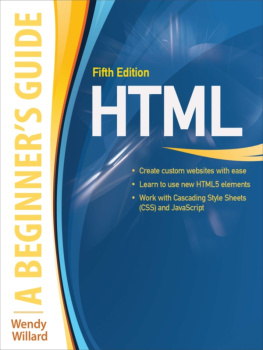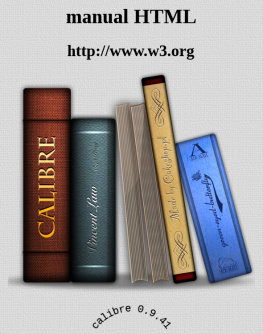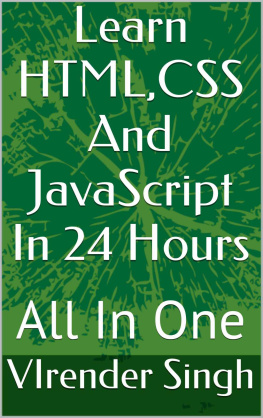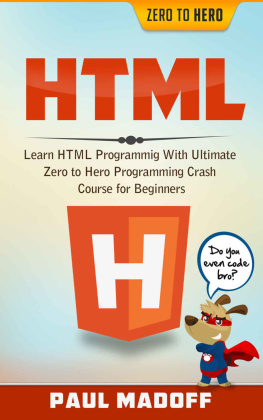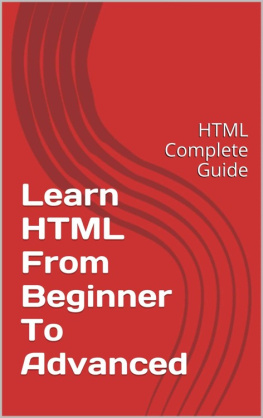David Maxwell - HTML Bootcamp: Learn The Basics Of HTML and CSS in 2 Weeks
Here you can read online David Maxwell - HTML Bootcamp: Learn The Basics Of HTML and CSS in 2 Weeks full text of the book (entire story) in english for free. Download pdf and epub, get meaning, cover and reviews about this ebook. year: 2016, publisher: CreateSpace Independent Publishing Platform, genre: Computer. Description of the work, (preface) as well as reviews are available. Best literature library LitArk.com created for fans of good reading and offers a wide selection of genres:
Romance novel
Science fiction
Adventure
Detective
Science
History
Home and family
Prose
Art
Politics
Computer
Non-fiction
Religion
Business
Children
Humor
Choose a favorite category and find really read worthwhile books. Enjoy immersion in the world of imagination, feel the emotions of the characters or learn something new for yourself, make an fascinating discovery.

- Book:HTML Bootcamp: Learn The Basics Of HTML and CSS in 2 Weeks
- Author:
- Publisher:CreateSpace Independent Publishing Platform
- Genre:
- Year:2016
- Rating:5 / 5
- Favourites:Add to favourites
- Your mark:
- 100
- 1
- 2
- 3
- 4
- 5
HTML Bootcamp: Learn The Basics Of HTML and CSS in 2 Weeks: summary, description and annotation
We offer to read an annotation, description, summary or preface (depends on what the author of the book "HTML Bootcamp: Learn The Basics Of HTML and CSS in 2 Weeks" wrote himself). If you haven't found the necessary information about the book — write in the comments, we will try to find it.
HTML Bootcamp: Learn The Basics Of HTML and CSS in 2 Weeks — read online for free the complete book (whole text) full work
Below is the text of the book, divided by pages. System saving the place of the last page read, allows you to conveniently read the book "HTML Bootcamp: Learn The Basics Of HTML and CSS in 2 Weeks" online for free, without having to search again every time where you left off. Put a bookmark, and you can go to the page where you finished reading at any time.
Font size:
Interval:
Bookmark:
HTML
Learn the Basics of HTML Programming in 2 Weeks!
More Free and Bargain Books at KindleBookSpot.com
Contents
Contents
.41
Introduction
Bonus : As a thank you Id like to offer you a gift. Ive included a few bonus books. Check out the very botom to find out how to get these!
I want to thank you and congratulate you for downloading the book, HTML: Learn the Basics of HTML Programming in 2 Weeks!
These days, using the internet is more than just a luxury: its a necessity. Sometimes, work cannot be done without doing research on the internet, but as someone whos interested in programming, have you ever wondered how those websites work and what goes on in them?
For starters, every website you see works because of a programming language called HTML, or Hyper Text Markup Language. Without HTML, websites would not work as fast as they could, and would not provide you with images, videos, or even audio. In short, those websites wont be as easy to navigate and easy on the eyes as they could be.
But, with the help of this book, youll learn the basics of HTML programming in just a matter of 2 weeksso you can start to make your own webpages, and in time, a full website, too!
Read this book now to find out how.
Thanks again for downloading this book, I hope you enjoy it!
Copyright 2014 by ______________________ - All rights reserved.
This document is geared towards providing exact and reliable information in regards to the topic and issue covered. The publication is sold with the idea that the publisher is not required to render accounting, officially permitted, or otherwise, qualified services. If advice is necessary, legal or professional, a practiced individual in the profession should be ordered.
- From a Declaration of Principles which was accepted and approved equally by a Committee of the American Bar Association and a Committee of Publishers and Associations.
In no way is it legal to reproduce, duplicate, or transmit any part of this document in either electronic means or in printed format. Recording of this publication is strictly prohibited and any storage of this document is not allowed unless with written permission from the publisher. All rights reserved.
The information provided herein is stated to be truthful and consistent, in that any liability, in terms of inattention or otherwise, by any usage or abuse of any policies, processes, or directions contained within is the solitary and utter responsibility of the recipient reader. Under no circumstances will any legal responsibility or blame be held against the publisher for any reparation, damages, or monetary loss due to the information herein, either directly or indirectly.
Respective authors own all copyrights not held by the publisher.
The information herein is offered for informational purposes solely, and is universal as so. The presentation of the information is without contract or any type of guarantee assurance.
The trademarks that are used are without any consent, and the publication of the trademark is without permission or backing by the trademark owner. All trademarks and brands within this book are for clarifying purposes only and are the owned by the owners themselves, not affiliated with this document.
Chapter 1: A Brief History of HTML
On the first week of the lesson, its best that you first get to know what HTML is really about.
HTML stands for Hyper Text Markup Language, which consists of a set of markup tags, and are described by HTML tags.
Markup tags make up the foundation of HTML where the use of nesting lines, such as or
are prevalent. This makes it a cornerstone technology, together with JavaScript and CSS . This makes it easy for whats on the web to also be shown on mobile deviceswhich is important these days because everyones mostly on their phones or tablets, and that is why you have to make sure that the websites you create are optimized for mobile devices.The development of HTML is widely attributed to Tim Berners-Lee, also known as the creator of the World Wide Web (www). Back in 1989, he was still a contractor as CERN, and while working there, he wrote a memorandum proposing for a hypertext system that will be based on the internet.
He then began to write server and browser software based on HTML back in the 1990s, and also created an encyclopedia based on it that CERN used as the foundation for the websites they created.
Berners-Lee was also the first one to use the term HTML Tags as the first available description of HTML. It was composed of 18 essential elements that made up the relative HTML design, and 11 of these elements are still used up to this day and age.
HTML was also defined for a time as one of the main applications of SGML, or Standardized Generalized Markup Language. It stayed that way up until 1993 when the first HTML Draft for the internet came into fruition. However, it just had to take 6 months before the said draft expired.
In 1994, the HTML Working Group was created and in turn, HTML 2.0 was finally completed in 1995, and in 1996, specifications for HTML started to be maintained. In 1999, HTML 4.1 was published, and in 2004, HTML 5 began to be developedproving how innovative the said language is.
Interactive forms, objects, and images are then easily embedded to websites with the help of HTML. Then, with the help of structural semantics. Quotes, links, lists, and paragraphs are all embedded, as well. HTML also works with JavaScript and CSS in such a way that browsers would be able to have scripts embedded in them.
Ever since 1997, programmers were encouraged to use HTML instead of CSS or Cascading Style Sheets for websites.
Chapter 2: Framework and Tags Cheat Sheet
The framework of HTML is made up of the following:
1. The document type is described with the DOCTYPE declaration.
2. Document information is provided in the text between
and .3. An HTML document is described in the text between and
.4. The documents title is provided in the text between .
5. The text between
6. The content of the documentor what youd read onscreengoes on the text between
and .7. And, a paragraph could then be created in the text between
and
Tags Cheat Sheet
Now, when it comes to tags, you have to keep in mind that they usually come in pairs, as you have seen in the framework above. Whats on the left side is the beginning of the tag (also known as start tag), and the end tag looks almost the samebut only with a slash (/) in the beginning.
Here are the tags that youre mostly going to use:
NAME this pertains to a section on the page
HREF this is used for hyperlinking, or for adding the name of the URL that you are referring to
onCLICK this is the script that runs so that the user will be able to click on the anchor (i.e., for things such as google.com , this script has to run so that the user would really be directed to a link after clicking)
Anchor
TITLE this is the title of the document that is being opened
onMOUSEOUT this is the script used to determine that the mouse is no longer on the anchor text
TARGET This shows the window where the document has to go into. Variations include: parent | black | top | shelf | window name
onMOUSEOVER this shows that the mouse is right over the anchor text
CODEBASE this is the path that would take you to the applet class
CODE this determines the app that is currently running
HEIGHT the height of the applet
WIDTH this determines the applets width
ALIGN this would determine how the surrounding text would show up onscreen
HSPACE this is the horizontal space between the surrounding text and the applet
Font size:
Interval:
Bookmark:
Similar books «HTML Bootcamp: Learn The Basics Of HTML and CSS in 2 Weeks»
Look at similar books to HTML Bootcamp: Learn The Basics Of HTML and CSS in 2 Weeks. We have selected literature similar in name and meaning in the hope of providing readers with more options to find new, interesting, not yet read works.
Discussion, reviews of the book HTML Bootcamp: Learn The Basics Of HTML and CSS in 2 Weeks and just readers' own opinions. Leave your comments, write what you think about the work, its meaning or the main characters. Specify what exactly you liked and what you didn't like, and why you think so.


